
Biology_of_Turtles
.pdf

8 Functional Evolution of
Feeding Behavior in Turtles
Vincent Bels, Sabine Baussart, John Davenport, Marc Shorten, Ruth M. O’Riordan, Sabine Renous, and Julia L. Davenport
Contents
8.1 |
Introduction......................................................................................................................... |
|
187 |
|
8.2 |
Objective.............................................................................................................................. |
|
188 |
|
8.3 |
Feeding Structures............................................................................................................... |
189 |
||
8.4 |
Overview of Feeding and Drinking Behaviors................................................................... |
189 |
||
8.5 |
Kinematics........................................................................................................................... |
|
192 |
|
|
8.5.1 |
Terrestrial Feeding................................................................................................... |
192 |
|
|
|
8.5.1.1 |
Ingestion...................................................................................................... |
192 |
|
|
8.5.1.2 |
Intra-oral Transport Cycle.......................................................................... |
195 |
|
|
8.5.1.3 |
Swallowing.................................................................................................. |
197 |
|
8.5.2 |
Aquatic Feeding....................................................................................................... |
198 |
|
|
|
8.5.2.1 |
Ingestion Cycle............................................................................................ |
198 |
|
|
8.5.2.2 Manipulation and Transport Cycle............................................................. |
204 |
|
|
8.5.3 Feeding in Dermochelys coriacea: A Typical Example of a Marine Turtle with |
|
||
|
|
a Highly Specialized Diet......................................................................................... |
204 |
|
|
|
8.5.3.1 |
Materials and Methods............................................................................... |
204 |
|
|
8.5.3.2 |
Results......................................................................................................... |
204 |
8.6 |
Evolution of Feeding Behavior in Turtles............................................................................ |
208 |
||
|
8.6.1 |
Ingestion................................................................................................................... |
208 |
|
|
8.6.2 |
Transport (and Other Feeding Phases)..................................................................... |
208 |
|
Acknowledgments.......................................................................................................................... |
|
210 |
||
References....................................................................................................................................... |
|
|
210 |
|
8.1Introduction
Turtles have one of the most unusual body plans among the amniotes, with a carapace that constrains their behavioral activities differently from all other tetrapods (Gaffney, 1979; Reisz & Laurin, 1991; Laurin & Reisz, 1995; Lee, 1997; Schaffer et al., 1997; Pough et al., 2001; Cebras-Thomas, 2005; Kear & Lee, 2006; Shedlock et al., 2007). Although the origin and evolution of this clade of vertebrates is still unclear despite thorough discussion (Joyce & Gauthier, 2004; Hill, 2005; Nagashima et al., 2005), such a body plan appears to be conservative. However, reduction of the shell has been reported in relation to chelonian life strategies, especially in aquatic turtles (Pritchard, 1979). Evolutionary transformations of the locomotor system in aquatic turtles enable them to display highly adapted mobility and maneuvering, presumably for optimizing searching for food, sexual partners, and areas for egg laying (Davenport & Clough, 1986; Renous & Bels, 1989; Wyneken, 1997; Chapter 5). Although some sea turtle populations nest and feed in the same general areas, others (species or populations within a species) can migrate over great distances. Leatherbacks have probably the
187

188 |
Biology of Turtles |
longest migration of all sea turtles because they can be found more than 7000 km from their nesting beaches (Hughes et al., 1998).
Despite their “armored tank” shape, turtles have adopted specialized foraging and feeding strategies derived from those of the stem reptiles that have provided enduring advantages while simultaneously imposing basic restrictions. The living species of turtles, distributed among 99 genera and 14 families (Ernst & Barbour, 1989), inhabit a large number of various ecological niches in marine, freshwater, and terrestrial habitats from temperate and tropical regions of all continents except Antarctica, and in all oceans. It is well known that turtles are either specialized or generalized in their diet, with possible ontogenic dietary shifts being common (Pritchard, 1979). Foraging and feeding behaviors have been generally described for almost all families of turtles (Pritchard, 1979). Dietary preferences and ontogenic changes during the life cycles of turtles have been reported in numerous species, particularly in marine turtles. Most chelonians show dietary fluctuations during their lives and can shift from carnivorous to omnivorous and herbivorous diets as they age (Harless & Morloch, 1979; McCauley & Bjorndal, 1999; Bouchard & Bjorndal, 2006). Briefly, true terrestrial turtles (Testudinidae) are the only species able to ingest and swallow food on land, so are subject to the same constraints as all other truly terrestrial vertebrates. Apart from these turtles, a large number of species make forays into terrestrial habitats for feeding and drinking (e.g., Emydidae). Some other species are wholly water-feeders and chase their food by using various strategies from active foraging to sit-and-wait predator behavior (e.g., softshells, Tryonichidae). Some species can capture live food on land but swallow it in water. Several herbivorous species (e.g., Bataguridae) can feed on plant material at the surface of the water or can drag terrestrial vegetation into the water (Davenport et al., 1992). Some species can feed on land or in water, completing the process from food capture to swallowing in either medium (e.g., Terrapene carolina, Emydidae). Although basking on land has been reported in a few cases, marine turtles are generally found on land only in two situations: when adult females return to the land for egg laying and when hatchlings must travel from the nest down the beach to the sea. Marine turtles always forage and feed in the water.
A series of phylogenetic studies have demonstrated significant relationships between various characteristics of the trophic system and corresponding ecological specializations in some groups of turtles (Gaffney, 1975, 1979; Claude et al., 2004). From these data, there have been several hypotheses generated to demonstrate a relationship between feeding performances and the phylogenetic hypotheses. For example, the morphological variation of the superfamily Testudinoidea relates to both diet and habitat (Claude et al., 2004). These authors suggest that aspects of the feeding mode (e.g., diet) can be a key factor in determining morphological evolution and diversification of turtle skulls. Phylogeny appears to constrain only localized features of the skull and remains of minor influence.
8.2Objective
There are substantial problems in providing a complete overview of the feeding behavior of turtles using aquatic and terrestrial habitats based only on previously published data: kinematic and functional analyses of complete feeding mechanisms are relatively rare, and feeding behavior has been studied using non-standardized methods and techniques. In his comprehensive volume of evolution of feeding behavior in tetrapods, Schwenk (2000) provides an exhaustive list of literature describing feeding behavior and mechanisms in turtles. The present chapter provides the first comparative analysis of feeding behavior in turtles. Though aquatic feeding has been studied in several very different representative species drawn from fresh water families, few data are available concerning the feeding behavior of marine turtles or of terrestrial turtles. Consequently, this chapter will not only provide information from the literature but will also present data collected by the chapter’s authors, together with their analyses of feeding behavior in terrestrial and aquatic species. All of these data are considered from a comparative viewpoint. When necessary, a rapid survey of the methods used

Functional Evolution of Feeding Behavior in Turtles |
189 |
for collecting data is provided for each of the feeding modes, terrestrial and aquatic. The mechanism of neck movements that play a key role in feeding in turtles is discussed in Chapter 7.
8.3Feeding Structures
Detailed analyses have been made of the skull, hyobranchium, and tongue in turtles (Lindeman, 2000; Schwenk, 2000; Claude et al., 2004). When needed, we provide morphological data that are necessary to explain the functional and biomechanical aspects of feeding behavior. Some functional analyses demonstrate how structures are used in various phases of feeding in aquatic turtles (Schwenk, 2000; Lemell et al., 2002).
8.4Overview of Feeding and Drinking Behaviors
A rapid survey of the evolution of turtles and their diet show that turtles use two main feeding strategies to gain water, energy, and nutrients: feeding/drinking on land and feeding in water. Drinking water is a particular problem for terrestrial turtles and for some turtles living in saline/marine habitats. All of these turtles need to drink water (when available) to maintain the hydric balance that is essential to welfare and survival. Water intake rates and frequencies are highly variable among turtles. For example, some desert turtles are able to consume a large amount of water in one intake, thereby increasing body mass by up to 40%. Drinking in aquatic turtles has been rarely described. A recent study demonstrated that hatchling sea turtles can osmoregulate effectively and gain mass by drinking sea water (Reina et al., 2002). Although well reported in the literature, drinking behavior has been quantified only in Malaclemys terrapin (Davenport & Macedo, 1990; Bels et al., 1995). This species is able to modulate its drinking posture in relation to the water source; it can drink from very thin films of fresh water either on the sea surface or on the surface of intertidal mud, and can even drink directly from falling rain or from water droplets on vegetation (Davenport & Macedo, 1990). Malaclemys can also forcibly expel water out of the bucco-pharyngeal cavity when disturbed during the drinking sequence, or when the volume of water within this cavity is too great. Malaclemys can expel water very quickly (less than 1 s) by a sudden gape increase accompanied by throat elevation and neck retraction (Bels et al., 1995).
As recognized for all vertebrates, feeding behavior in turtles is a modal-action-pattern (MAD), involving movements of the trophic elements integrated with neck displacements, sometimes associated with complex limb movements, sometimes not. All of these coordinated sensori-motor movements define the feeding strategy of turtles. Any food item consumed by turtles (from plant material to fast-moving mobile prey) must be located and ingested by a rhythmic series of head, jaw, and hyolingual movements. There are three major successive phases in terrestrial turtles (Schwenk, 2000): ingestion (capture), transport and intrabuccal manipulation, and swallowing. A fourth phase called pharyngeal packing occurs at the end of several feeding sequences but does not involve any jaw opening-closing cyclic movement (Figure 8.1). Since the earliest functional studies of vertebrates, a clear difference has been demonstrated between feeding strategies in water and on land (Liem, 1990). Incompressible water can be used to drive a mobile food item (living prey) into the buccal cavity by producing negative pressure inside that cavity. When food is caught, it must be transported and swallowed.
All feeding phases are based on rhythmic coordinated series of movements of the trophic elements (e.g., jaws, tongue, hybranchium) associated with neck movements producing whole displacement of the head (Figure 8.1). These movements are probably the result of rhythmic jaw movements generated by a central neuronal population called the central pattern (or rhythm) generator (CPG) (Schwenk, 2000). All rhythmic jaw opening-closing activities are modulated by sensory feedback generated by various structures within the buccal cavity. For example, taste buds have been described in the buccal and tongue epithelium of several species of turtles (Iwasaki, 1992, 2002; Iwasaki et al., 1996a, 1996b, 1996c, 1996d; Beisser et al., 2001). Although a large number of
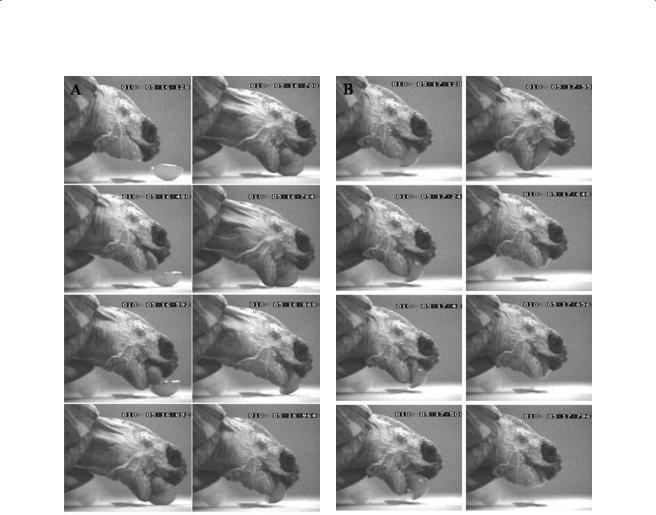
190 |
Biology of Turtles |
Figure 8.1 Series of frames depicting the successive events of a typical feeding sequence in Geochelone radiata eating a piece of grape. (A) Ingestion cycle, (B) transport cycle, (C) swallowing or pharyngeal packing, and (D) pharyngeal compression. Food ingestion always involves contact by the tongue prior to surrounding by the jaws for grasping. Food ingestion and transport involve rhythmic cyclic jaw and tongue movements. In transport, the forward movement of the tongue is modulated by the position of the food in the buccal cavity. In swallowing, the mouth is opened and the food moved toward the pharynx. In pharyngeal compression, the jaws always remain closed. The timing of each frame is provided in ms (last three numbers recorded on the frames).
studies provide information on the foraging behavior of turtles, no quantitative analysis has actually demonstrated the effect of food properties (i.e., texture, volume, size) on the modulation of the movements of the trophic system (e.g., jaws, tongue, and hyobranchium). In the majority of studies, turtles have been fed in the laboratory on standardized prey items (e.g., live fish as elusive prey) or plant material (e.g., fruits and lettuce items for terrestrial species, available plants for aquatic species) for herbivorous species.
For aquatic turtles mainly living on the substratum, hunting strategies usually involve immobility while awaiting prey proximity before striking, or moving slowly toward the prey. For example, a very slow (0.4 cms-1) stalking motion is reported in the highly camouflaged pleurodiran Chelus fimbriatus that moves toward its prey until the tip of the snout is close to the prey itself (Lemell et al., 2002). Lemell and Weisgram (1997) described the feeding sequence in the aquatic Pelusios castaneus while catching prey on the substratum by associating movements of the turtle and the use of the trophic system. Lauder and Prendergast (1992) described a preparatory phase in
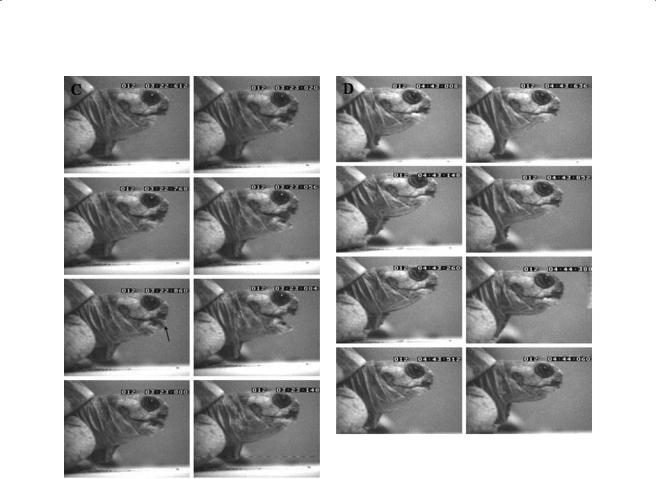
Functional Evolution of Feeding Behavior in Turtles |
191 |
Figure 8.1 (continued)
Chelydra serpentina feeding on various prey types that consists of a slow, voluntary stalking movement with little horizontal body and neck movement before a fast opening of the mouth associated with a sudden neck extension (see Chapter 7). Slow stalking movement prior to mouth opening was also reported in M. terrapin eating food on the substratum (Bels et al., 1998).
From a functional point of view, it is rather difficult to determine the integration between locomotor and trophic systems for these turtles because in the laboratory, food is often presented at too short a distance from the head to measure the kinematic and hydrodynamic characteristics of the feeding behavior. However, it is clear that the neuromotor integration between both systems plays a particularly key role when turtles are hunting in the water column, or when the prey items show specialized behavior or physical texture (e.g., shells in mollusks and crustaceans). Many aquatic turtles must associate complex limb movements with neck movements and rhythmic movements of the trophic system to support the complex maneuvering ability that improves food capture success (Figure 8.2). Davenport and Clough (1985) report an apparently unique feeding behavior that involved the use of the fore flippers to gain food in the marine turtle Caretta caretta. These authors observed the role of “pseudoclaws” (sharp-pointed scales) on the proximal portions of the forelimbs of young specimens to allow the combined use of foreflippers and beak to tear food items that are otherwise too large to be swallowed whole or readily bitten into chunks (thus mimicking the feeding behavior of freshwater turtles such as emydids that use true claws and the beak to achieve a similar goal) and allowing food morsels adhering to the pseudoclaws to be ingested by the turtle.
Feeding behavior in the brackish-water emydid M. terrapin is the best example currently available in the literature to demonstrate plasticity in neuromotor integration of limb, neck, and trophic systems during prey capture (Bels et al., 1998). Capturing immobile prey (e.g., mussels) on
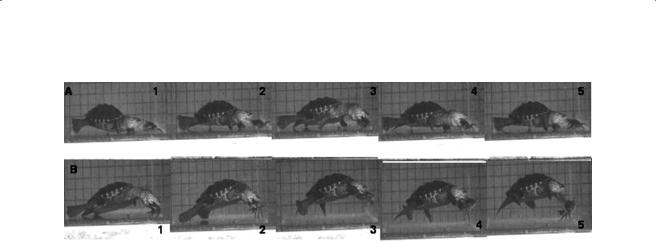
192 |
Biology of Turtles |
Figure 8.2 Two typical feeding sequences of Malaclemys attacking a defending crab. These sequences show the complex interaction between the turtle and the living prey. However, images show the stereotyped pattern of neck extension, gape cycle, and throat depression for both attempts to ingest parts of the crab. The arrow shows the jumping behavior of the crab attacking the turtle that defends by biting (corresponding to ingestion cycle).
the substratum is mainly achieved by coordinated neck extension and jaw opening with relatively small inertial suction (Van Damme & Aerts, 1997; see following for discussion). Capturing mobile and aggressively defensive prey in the water column (e.g., living crabs) requires coordination of neck extension and jaw opening with the limb cycles used for swimming. In all cases, the neck is extended to place the opening jaws close to the prey during limb retraction, to increase the thrust of the turtle toward the prey (Figure 8.2). Another sort of coordination of limb, neck, and jaws has also been described. Bels and Renous (1992) and Bels et al. (1998) demonstrated that feeding on soft, slowly swimming prey (jellyfish) by young leatherback turtles always involves placement of the long foreflippers alongside the body during the catching cycles. They suggest that this strategy strongly decreases the possibility of limb movements displacing jellyfish away from the buccal cavity. In terrestrial habitats, turtles often approach food slowly and stop all movements before capturing the prey or biting the plant material.
The use of the limbs in all other feeding phases remains relatively poorly understood. For turtles feeding in the water column (e.g., Emydidae), the limbs play a major rule in optimizing food transport (Bels et al., 1998); typically, the forelimb claws are used to tear large food items into smaller pieces. However, for turtles that feed in terrestrial habitats, the limbs only play an occasional role by stabilizing the position of a food item on the substratum or aiding the seizure of “difficult” hard food items between the jaws (e.g., Testudinidae eating living prey such as snails). All of these examples show that functional studies must be ecologically relevant to yield a full understanding of turtle feeding strategies and their plasticity that plays a key role in the overall fitness of the organism.
8.5Kinematics
8.5.1Terrestrial Feeding
8.5.1.1Ingestion
Two modes of food prehension have been reported for terrestrial turtles: lingual prehension and jaw prehension (Figure 8.1 & Figure 8.3). A clear difference in ingestion cycles has been reported for Terrapene sp. feeding on insects and Geochelone sp. feeding on plant material. T. carolina and T. ornata never use lingual prehension but only jaw prehension when catching insects (e.g., Bels et al., 1997). Geochelone sp. and Testudo sp. always use lingual prehension for feeding on plant material. For mobile prey (mealworms, as used in Terrapene studies), Kinixys also uses lingual prehension. However, no quantitative comparative analyses of the modulatory effects of food items
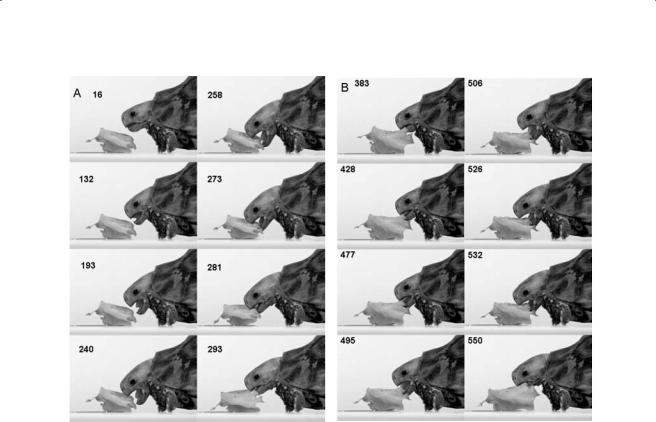
Functional Evolution of Feeding Behavior in Turtles |
193 |
Figure 8.3 Series of frames depicting the successive events of a typical feeding sequence in Kinixys belliana eating a piece of lettuce: (A) ingestion cycle and (B) transport cycle. Food prehension does not involve contact by the tongue outside the buccal cavity. Food transport involves rhythmic cyclic jaw and tongue movement. Contact between tongue and food occurs within the buccal cavity. In transport, the forward movement of the tongue that plays the key role is modulated by the position of the food in the buccal cavity. The timing of each frame is provided in ms (last three numbers recorded on the frames).
on kinematic and motor variables have yet been reported in these representative tortoises of Testudinidae. In cases of living prey (e.g., insects), only one ingestion cycle is used to catch the food and drive the food item into the front of the buccal cavity. In Terrapene sp. studied with this food item, the jaw moves quickly around the prey and the tongue is never used for prehension of insects (Bels et al., 1997). For plant material, the ingestion (capture) cycle is more complex and depends on the size of the food item because the feeding bout is a continuous process that does not terminate at one particular phase. Two examples demonstrate this complexity. For relatively large food items such as grapes, G. radiata contacts the food with the tongue and retracts the food item within the buccal cavity while the jaws are moving around the food. The turtle usually uses one to three ingestion cycles to bring the food material successfully into its buccal cavity. Similar behavior has been reported for the herbivorous lizard Uromastix fed on endive (Herrel et al., 2002). The G. radiata head is then placed in an approximately horizontal position during the immediately subsequent cycles, allowing transport and intrabuccal manipulation; for “long” food items such as lettuce leaves that are drawn into the mouth by rhythmic jaw cycles, the food items are caught by the tongue and the jaws move the piece of food around several times before the food partly or completely enters the buccal cavity. It is rather difficult to separate food ingestion and transport because at each tongue cycle (Figure 8.1 and Figure 8.3), the food within the buccal cavity is moved by the mid and posterior portions of the tongue while the foretongue moves to adhere to the parts of the food item that are still outside of the buccal cavity. When a piece of food is cut off, the turtle can stop to ingest the rest of the food item, which continues to be acted upon only by transport cycles. Such a continuous

194 |
Biology of Turtles |
process of ingestion-transport is strongly influenced by the size of the food material. When a short piece of lettuce is provided to turtles, only one or two ingestion cycles are used to deal with the food. The effect of the size of the food item on the continuous process involving the foretongue to catch the food item and the midand hindtongue portions for transporting the food has been clearly demonstrated in all herbivorous mammals feeding on long pieces of hay (Bels, 2006), so this process is not unusual in vertebrates. As soon as the food is within the buccal cavity of G. radiata, a series of integrated head (neck), jaw, and hyolingual cycles termed transport-intrabuccal manipulation move the food posteriorly toward the pharynx. At the end of a complete sequence, cycles determining the swallowing phase typically show a different gape profile as has been noted in herbivorous lizards (Herrel & De Vree, 1999).
In both modes of food prehension, turtles always use combined movement of the jaws, the head, and the neck that may or may not be associated with displacements of the hyolingual apparatus. All ingestion cycles in all terrestrial turtles are accompanied by neck extension, moving the opening jaws toward the food item (Figure 8.4). During the next extension, the head is positioned relative to the food item depending on the properties of the food and its proximal cues (i.e., size, volume, texture, mobility), showing a complex sensory-motor mechanism controlling the initiation of this feeding phase. At each ingestion cycle, the turtle rotates the head in various positions to be able to take hold of the plant material. The sensory-motor mechanisms underlying such functional plasticity during ingestion remain understudied. In terrestrial turtles, the question of positioning the head together with a neck extension remains an open question. Probably differences in the speed of head movements toward the food are key parameters that permit these reptiles to modulate head rotation during food ingestion. This difference can be seen as a functional consequence of diet selection in terrestrial turtles.
Two main types of ingestion cycles have been reported: jaw prehension and lingual prehension. In both modes of food prehension, turtles always use combined movements of the jaws, the head, and the neck, associated or not with displacements of the hyolingual apparatus. In all prehension, the mouth is opened in slow (SO) and fast (FO) stages (Figure 8.4). However, the duration of SO stage is variable. In T. carolina and T. ornata, a clear distinction between SO and FO stage was not always easy to determine because the gape increases rather regularly, and often the mean duration of FO stage is longer than that of the fast closing (FC) stage. The tongue always moves forward within the buccal cavity during gape increases and retracts during the beginning of the FO stage. Upon protrusion, the tongue bulges and the tongue tip curves ventrally, so that the foretongue makes contact with the food item. During the SO phase, the tongue is protruded from the mouth and contacts the food. Next, the tongue continues to be extended and pushed against the food item. The food is then maintained in contact with the tongue because of strong mucous adhesion between the tongue surface and the food. Once the tongue has been retracted within the jaw margins, the jaws are closed quickly, and the slow closing/power stroke phase started. The mean duration of the FO stage is longer than that of the FC stage. During the decrease in gape size, the lower jaw arrives under the beak formed by the upper jaws as in transport cycles. The tongue moves forward while the gape increases and contacts the food before maximal gape is achieved. Retraction of the tongue occurs during the beginning of the FO stage. After closing the jaws on the prey, the head retracts and rotates in reverse. Timing of kinematic events of G. elephantopus (lingual prehension) and T. carolina (jaw prehension) is similar in these different species (Figure 8.4). For example, peak hyoid retraction occurs just after peak gape angle and maximum throat depression occurs 30 to 100 ms after maximum gape angle. The successive six events in both turtles can be summarized as follows:
•Neck extension to drive the head toward the food
•Opening of the mouth (SO and FO stages)
•Retraction of the tongue during the beginning of the FO stage
•Depression of the throat immediately following the tongue retraction
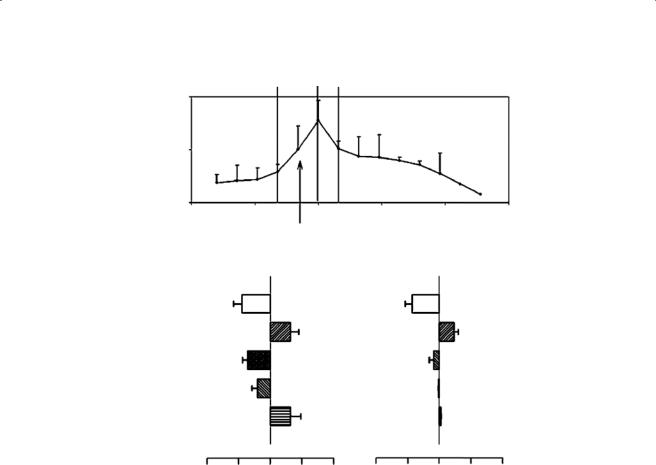
Functional Evolution of Feeding Behavior in Turtles |
195 |
Mean Gape Angle (degrees)
|
A |
|
|
|
50 |
SO |
FO |
FC |
SC |
|
||||
25 |
|
|
|
|
0 |
|
|
|
|
–2 |
–1 |
0 |
1 |
2 |
3 |
|
TTOR |
|
Time (s) |
|
|
|
|
|
|
|
|
B |
Maximal Gape |
|
|
Maximal Gape |
|
TBNE
TMNE
TTOR
TBTD
TMTD
–1.0 |
–0.5 |
0.0 |
0.5 |
1.0 |
–1.0 |
–0.5 |
0.0 |
0.5 |
1.0 |
|
|
Time (s) |
|
|
|
|
Time (s) |
|
|
|
G. elephantopus |
|
|
|
C. carolina |
|
|||
Figure 8.4 (A) Mean gape profile (± standard deviation) from 10 lateral ingestion cycles in one specimen of Geochelone elephantopus. The arrow indicates the mean time of tongue retraction. (B) Comparison between timing events in G. elephantopus and T. carolina (data from Bels et al., 1997). Timings were calculated from the time to peak gape angle (time 0). Gape is divided into slow opening (SO), fast opening (FO), fast closing (FC), and slow closing (SC). TBNE: time to beginning of the neck extension, TMNE: time to maximal neck extension during ingestion cycle, TTOR: time to tongue retraction, TBTD: time to beginning of throat depression, TMTD: time to maximum throat depression.
•Closing of the mouth on the food
•Retraction of the head toward the carapace.
8.5.1.2 Intra-oral Transport Cycle
As soon as the food (e.g., living prey, plant material) enters the buccal cavity, transport of the food toward the pharynx begins. For example, after ingestion of a mealworm, the prey is not completely held within the buccal cavity and is reduced (i.e., partially crushed) by the jaw margins at each transport cycle (Figure 8.3 and Figure 8.5). Because the mealworm enters the buccal cavity progressively, successive portions of the mealworm are reduced at the closing stage of each transport cycle.
The slow opening of the mouth during transport is composed of the SO I (opening) and often SO II (stationary stage) stages. The FO stage corresponds to a rapid increase in the vertical displacement of the jaws (Figure 8.5). The FO stage begins after a slight decrease in gape angle at the end
